Scientists have revealed the results of studies on samples taken from the asteroid Ryugu. Japan’s Hayabusa 2 mission collected the samples in 2018 and 2019 (via Space.com). The results include a breakdown of what the asteroid is made of. Additionally, the results showed that asteroids like Ryugu could have helped bring the seeds of life to Earth.
DON’T MISS: Deals: AirPods Pro sale, $14 bed pillows, $200 off MacBook Pro, more
Collecting samples with the Hayabusa 2

Back in 2018, Japan’s Hayabusa 2 mission collected rocky particles from the surface of the asteroid Ryuga. Later, in 2019, the spacecraft returned to the asteroid and collected particles from beneath the asteroid’s surface by creating a small crater. Within these samples, the scientists say they discovered key amino acids. These amino acids are part of what make up the seeds of life found throughout our universe.
What’s more intriguing is that Ryugu appears to contain more of these seeds than any other asteroid we’ve discovered like it. We discovered these other asteroids after they landed on Earth, which is what helped scientists make the connections between the two. Scientists classify these asteroids as CI chondrite asteroids.
In a paper presented at the Lunar and Planetary Science Conference of 2022, Hiroshi Naraoka, and a team of researchers studying the samples, noted that the samples taken from Ryugu contained higher levels of carbon, hydrogen, and nitrogen than other asteroids like it. They also found that samples taken from Ryugu appeared to be more “primitive” than those from other CI chondrite asteroids.
Teeming with the seeds of life

The scientists believe that the seeds of life found on Ryugu are more primitive because they haven’t interacted with the Earth’s environment. As such, they are more like the materials that made up the early solar system.
This discovery has led many to believe that asteroids like Ryugu could have played a big part in getting the seeds of life onto the planet. This isn’t the first time that scientists have leaned towards this kind of conclusion, either.
Previously, some scientists reported that solar winds had helped play a part in life growing on Earth. A study released earlier this year backed up some of those claims. Other researchers that the basic building blocks of life, peptides, can be created in space. Previously we believed that peptides needed water to form.
Naraoka believes the seeds of life found on Ryugu could spread through the universe as interplanetary dust. This dust could have come from Ryugu’s surface thanks to impacts with objects in space.
By studying asteroids like Ryugu, scientists can get a deeper look at the past, and the part that these asteroids may have played in spreading the seeds of life to Earth, and maybe even to other planets somewhere out there.







